
Journal of Superhard Materials
Scope & Guideline
Empowering researchers through cutting-edge findings in superhard materials.
Introduction
Aims and Scopes
- Synthesis and Processing Techniques:
Research on various synthesis methods for superhard materials, including High-Pressure High-Temperature (HPHT) techniques, spark plasma sintering, and chemical vapor deposition (CVD), aimed at improving material properties. - Characterization and Mechanical Properties:
Studies focusing on the physical and mechanical properties of superhard materials such as hardness, wear resistance, thermal conductivity, and strength, utilizing advanced characterization techniques. - Applications of Superhard Materials:
Exploration of the applications of superhard materials in cutting, grinding, and drilling tools, as well as in abrasives and coatings, emphasizing practical implementations in industry. - Advanced Composites and Hybrid Materials:
Development and investigation of composite materials that combine superhard phases with other materials to enhance performance, including studies on the mechanical behavior and stability of these composites. - Theoretical Studies and Modeling:
Theoretical approaches and computational modeling to predict the behavior and properties of superhard materials, including phase diagrams, electronic properties, and thermodynamic calculations.
Trending and Emerging
- High-Entropy and Composite Materials:
There is an increasing focus on high-entropy alloys and composite materials that incorporate superhard phases, indicating a trend towards developing multifunctional materials with superior properties for various applications. - Nanostructured and Ultradurable Materials:
Research on nanostructured superhard materials and their unique properties is on the rise, reflecting a growing interest in how nanoscale engineering can enhance hardness and wear resistance. - Environmental and Sustainable Approaches:
An emerging theme is the investigation of sustainable synthesis methods for superhard materials, including the use of recycled materials and eco-friendly processes, in response to global sustainability challenges. - Advanced Coatings and Surface Treatments:
The development of advanced coatings and surface treatments for enhancing the performance of tools made from superhard materials is trending, as industries seek to improve durability and efficiency. - Theoretical and Computational Modeling:
There is a notable increase in research utilizing theoretical and computational methods to predict the properties and behaviors of superhard materials, signaling a trend towards integrating simulation with experimental work.
Declining or Waning
- Natural Diamond Applications:
Research related to the applications of natural diamonds in industrial settings has decreased, likely due to the increasing prevalence and performance of synthetic alternatives that offer more controlled properties. - Traditional Abrasive Materials:
Studies focusing on traditional abrasive materials, such as natural diamond powders, have seen a decline, indicating a shift towards more innovative and engineered abrasives that provide enhanced performance. - Basic Research on Diamond Growth Mechanisms:
While foundational studies on diamond growth mechanisms were once prevalent, there has been a shift towards more applied research, leading to a decrease in publications purely focused on the growth processes of diamond.
Similar Journals
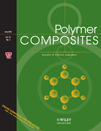
POLYMER COMPOSITES
Elevating Knowledge in Polymer SciencePOLYMER COMPOSITES, published by WILEY, is a leading journal dedicated to advancing the fields of materials science and engineering through the exploration of polymer composite materials. With its foundation dating back to 1980, this esteemed journal has continuously provided a platform for researchers to publish high-quality studies and innovative methodologies in areas such as ceramics, composites, and miscellaneous chemistry. Ranked in the prestigious Q1 quartile for sectors like Polymers and Plastics as well as Materials Chemistry, POLYMER COMPOSITES stands significant within the academic community, holding a notable impact factor that reflects its influence. The journal encompasses a comprehensive range of topics, making it essential reading for professionals, researchers, and students aiming to stay at the forefront of developments in polymer science and composite technologies. Although it does not currently offer Open Access, readers can access its impactful publications through institutional or individual subscriptions, contributing to ongoing advancements in the field and facilitating the exchange of valuable knowledge among scientists and engineers worldwide.

Acta Metallurgica Slovaca
Connecting academia and industry through cutting-edge findings.Acta Metallurgica Slovaca is a distinguished open-access journal published by SCICELL SRO that has been pivotal in the field of Materials Science and Metallurgy since its inception. With a robust commitment to disseminating high-quality research, this journal covers a wide array of topics within the scope of metals and alloys. Now indexed in Scopus, it ranks 82nd out of 176 in its category, reflecting a growing influence within the scientific community. With a quartile ranking of Q3 as of 2023, Acta Metallurgica Slovaca serves as an essential platform for researchers and professionals seeking to share innovative findings and developments in metallurgical science. Open access since 2013, it ensures that research is accessible to all, fostering collaboration and engagement across academia and industry worldwide. With a converged publication timeline extending from 2009 to 2024, this journal continues to play a crucial role in advancing knowledge and addressing contemporary challenges in the metallurgy sector.

Chalcogenide Letters
Illuminating the Future of Chalcogenide ApplicationsChalcogenide Letters is a prominent academic journal dedicated to the rapidly evolving field of chalcogenide materials, emphasizing their electronic, optical, and magnetic properties. Published by VIRTUAL CO PHYSICS SRL in Romania, this journal has established itself as a crucial source of scholarly research since its inception in 2006, with a convergence period extending to 2024. Although currently classified under the Q3 quartile in various categories including Chemistry (miscellaneous), Electronic, Optical and Magnetic Materials, and Physics and Astronomy, it serves as a platform for innovative research and discussions, attracting contributions from a global network of researchers and professionals. This journal presents an excellent opportunity for academics and students alike to engage with contemporary studies and breakthroughs in chalcogenide science. While it operates on an open-access model, the lack of an impact factor does not diminish its potential; rather it highlights the journal's commitment to serving the scientific community in a competitive landscape. With Scopus rankings positioning it in the lower percentiles across several categories, Chalcogenide Letters continues to evolve and expand its influence within the scientific discourse of materials science.
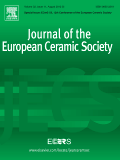
Journal of the European Ceramic Society
Advancing the Frontiers of Ceramic InnovationThe Journal of the European Ceramic Society, published by Elsevier, is a premier academic periodical dedicated to the cutting-edge advancements in the fields of ceramics and composites, as well as materials chemistry. With an impressive impact factor that places it in the top quartile (Q1) of its category, it ranks #33 out of 317 in Materials Science and #16 out of 127 in Ceramics and Composites, showcasing its strong influence in the scientific community. Established in 1989 and set to converge until 2025, this journal serves as a critical platform for researchers and professionals to disseminate their findings, share ideas, and foster collaboration in the rapidly evolving area of ceramic materials. Although it does not offer Open Access options, the journal ensures rigorous peer review and maintains high standards for publication, making it an essential resource for students, academics, and industry experts who are pushing the boundaries of material science.
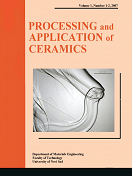
Processing and Application of Ceramics
Unlocking the Potential of Ceramic MaterialsProcessing and Application of Ceramics is a prominent open-access journal dedicated to the advancement of knowledge in the field of ceramics and composites. Published by the University of Novi Sad, Faculty of Technology in Serbia, this journal has been fostering research and innovation since its inception in 2007. With its ISSN 1820-6131 and E-ISSN 2406-1034, this journal is indexed in Scopus, where it holds a ranking of #82 out of 127 in the Materials Science category, placing it in the 35th percentile and within the Q3 quartile as of 2023. Spanning a convergence period from 2014 to 2024, the journal serves as a vital platform for researchers, professionals, and students alike, eager to explore the latest developments in ceramic materials, their processing techniques, and practical applications. The journal's commitment to accessibility and quality makes it an essential resource for those aiming to stay at the forefront of ceramics research.

PHYSICS AND CHEMISTRY OF MINERALS
Advancing Insights into Mineral InteractionsPHYSICS AND CHEMISTRY OF MINERALS, published by SPRINGER, is a premier journal dedicated to advancing the understanding of the physical and chemical properties of minerals, their interactions, and their significance in various geological processes. With an ISSN of 0342-1791 and an E-ISSN of 1432-2021, this journal serves as a vital resource for researchers and professionals in geochemistry and petrology, as well as materials science. Reflecting the journal's commitment to quality scholarship, it has achieved Q3 rankings in both Geochemistry and Petrology, and Materials Science (miscellaneous) categories. Established in 1977 and continuing through 2024, the journal has consistently provided a platform for high-impact research, fostering collaboration and innovation in the field. Located in Germany and reaching a global audience, PHYSICS AND CHEMISTRY OF MINERALS is instrumental for students, academics, and industry experts looking to stay at the forefront of mineral research and applications.
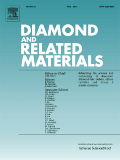
DIAMOND AND RELATED MATERIALS
Exploring the brilliance of diamond research.DIAMOND AND RELATED MATERIALS, published by Elsevier Science SA, serves as a premier international platform for the dissemination of high-quality research in the fields of materials science, electrical engineering, and chemistry, with a specialized focus on diamond and its related materials. With an ISSN of 0925-9635 and an E-ISSN of 1879-0062, this journal has established itself within the top quartiles, reflecting its influential contribution to the scientific community, particularly in the categories of Chemistry (miscellaneous) and Electrical Engineering, among others. The journal's wide scope encompasses both theoretical and applied aspects of diamond research, making it an essential resource for professionals and academics alike. The current rankings position it favorably within its respective disciplines, with a notable 79th percentile in General Physics and Astronomy and strong standings in related categories. Although it does not offer open access, researchers can stay informed of cutting-edge advancements and methodologies through its comprehensive articles and reviews, enriching the wider discourse in advanced materials research.
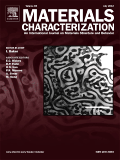
MATERIALS CHARACTERIZATION
Innovating Characterization Techniques for TomorrowMATERIALS CHARACTERIZATION is a leading international journal dedicated to the advancement of knowledge in the field of materials science and engineering. Published by Elsevier Science Inc, this esteemed journal has been disseminating vital research since 1970 and continues to be essential for scholars and industry professionals alike. With an impressive impact reflected in its Q1 quartile rankings across several categories—including Condensed Matter Physics, Materials Science, Mechanical Engineering, and Mechanics of Materials—MATERIALS CHARACTERIZATION stands out as a premier outlet for innovative studies and technical advancements. Researchers can access a wealth of peer-reviewed articles that explore properties, characterization techniques, and applications of materials, fostering interdisciplinary collaboration. With a commitment to high-quality research and comprehensive review processes, the journal plays a crucial role in shaping the future of materials science, making it an invaluable resource for anyone invested in this dynamic field.
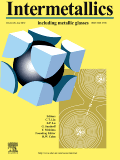
INTERMETALLICS
Exploring the Depths of Intermetallic InnovationINTERMETALLICS, a prestigious journal published by ELSEVIER SCI LTD in the United Kingdom, has been a vital resource in the fields of Materials Science, Mechanical Engineering, and Chemistry since its inception in 1993. Renowned for its rigorous peer-review process and commitment to high-quality research, this journal enjoys an impressive position within the top quartile (Q1) rankings of its categories, signifying its influence and esteem in the academic community. With a particular emphasis on the study of intermetallic compounds and their applications, INTERMETALLICS attracts groundbreaking research and innovative contributions that push the boundaries of knowledge in metals and alloys, as well as mechanics of materials. Researchers looking for a platform to disseminate cutting-edge findings will find this journal an exemplary choice, further enhanced by its commendable Scopus rankings that illustrate its widespread recognition and relevance. Though it does not currently offer Open Access options, the journal remains committed to advancing the field through selective publication of impactful research, making it an essential reference for researchers, professionals, and students alike interested in the dynamic interplay between materials and engineering.
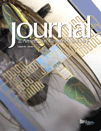
JOURNAL OF THE AMERICAN CERAMIC SOCIETY
Advancing the Frontiers of Ceramics ResearchJOURNAL OF THE AMERICAN CERAMIC SOCIETY, a prestigious publication within the field of ceramics and materials science, has been at the forefront of advancing research since its inception in 1918 and will continue to be a leading resource through 2024. Published by WILEY, this journal boasts an impressive impact factor, reflecting its strong reputation in the academic community. With its categorization in the Q1 quartile for both Ceramics and Composites and Materials Chemistry, the journal is ranked among the top in its fields, placing it in the 78th and 76th percentiles, respectively, according to Scopus metrics. Although not an open-access journal, it provides critical insights, robust research findings, and a platform for experts to disseminate their work, making it an essential resource for researchers, professionals, and students alike who are engaged in ceramic sciences and materials innovation. The Journal’s meticulous peer-review process ensures the highest quality and relevance of publications, fostering a rich environment for academic discourse and collaboration.